You don't really need a new reason to go to Ireland.
Genuine people, invigorating scenery and life-altering golf on some of the game's most inspiring links courses are all the motivation anyone should need.
But if you're the golf traveler who likes a strategy to your journey – like, in Scotland, playing only British Open venues or courses you can reach by train – you could do no better than this plan: Spend a week in Ireland playing gorgeous courses (and often unknown by most Yanks) designed by one of golf's most unlikely barons, Pat Ruddy, who might join you for an apple tart at the end of your travels.

Now edging into his 70s, Ruddy is a jovial, worldly, former freelance golf journalist – that alone makes this more like a fairy tale – who somehow saved enough money to build, along with son, Gerry, a world top 100 course crafted almost entirely with their own equipment and labor. That homemade masterpiece, The European Club, opened in 1992 on some secluded linksland along Brittas Bay, 35 miles south of Dublin.
Soon the world's best golfers and golf writers came to see for themselves. In 1999, a panel of experts from 12 international golf magazines selected three holes from The European Club to be named among "the world's 500 greatest golf holes", a stunning feat for any course, but astonishing for one just seven years old. Soon after, without any public relations campaign -- Ruddy does little advertising -- golf magazines in America and Britain declared the club among the finest hundred courses in the world.
"Magnificent," declared three-time British Open winner Nick Faldo on his first visit.
"I would love to see the British Open played there," announced former U.S. Open champion Johnnie Miller. When Padraig Harrington won his back-to-back British Opens in 2007 and 2008, guess where he did all his pre-tournament practice?
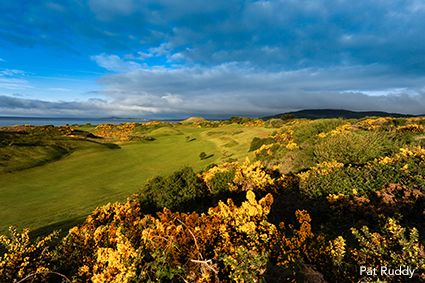
And before the 2002 British Open, Tiger Woods came and shot a course record 67, which still stands. To Ruddy's delight, Woods often stood on the tee boxes of par-fours and asked, "Is this a par five?" suggesting that Ruddy's beloved optical illusions had bloomed nicely.
Ruddy says he has received more than a dozen serious offers for the course, the last one reportedly in the neighborhood of $40 million – a very nice neighborhood for, ahem, a mere golf writer.
But we're getting ahead of ourselves. We'll save The European Club for later.
Last summer, I set out on a mini-Ruddy tour, hoping to hit three of the best of the 30-plus courses he has designed or renovated extensively in Ireland. Outside of the golf-design cognoscenti in the States, hardly anyone back home will have heard of them, but they are the equal of Ireland's very best – such as Ballybunion Old, Royal County Down, Lahinch – and because these true championship courses are so remote they often cost a third of what the cathedrals above will charge.
And I had yet another reason. Though I have known Ruddy for about 15 years and have played each of these courses a few times – true confessions here – sometimes golf travel writers are cursed by weather and don't see great courses at their finest.
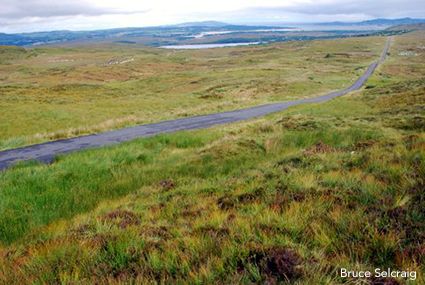
Such has been the case with Ballyliffin.
On the farthest northern reaches of Ireland – Newfoundland seems close; Dublin is 172 miles, Belfast 98 – this town of barely 1,000 hearty folks has not one, but two marvelous golf courses. And for years, I had only seen them in hellacious rain or wind.
Despite the stormy tales, in two decades of golf in Ireland, I've only twice had weather rob me of an entire day of golf – both times in this neck of the woods, in County Donegal. On my previous visit to Ballyliffin, the skies were blue but a near-constant 40 mph wind threatened to airlift the local cows. The members weren't fools. They stayed inside the newish steel-and-glass clubhouse with the gregarious head pro, John Farren, having their steaming chowder, while a few intrepids went to the range to test their manhood.
Nature won in about 10 minutes. So, I left that day without fully appreciating either the stunning Old Links – opened in 1973, designed by the immortal Eddie Hackett, then finally reinvigorated in 2006 by Nick Faldo (and later, Ruddy) to its superb standards today – or the Glashedy Links, one of Ruddy's finest works.
Last summer, making amends, the sky had never shown so brightly on the low green hills that nestle Ballyliffin. We had a full day of short sleeves, and even the choppy gray Atlantic's Pollan Bay looked like jam on toast. I recall someone getting a sunburn. In Ireland!
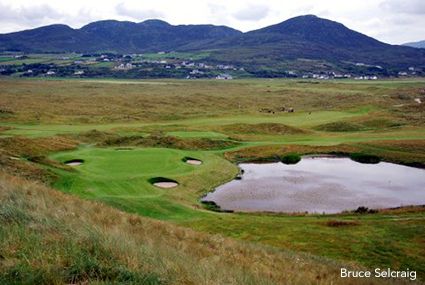
As Ruddy tells it, he and his late design partner, Tom Craddock, were first approached in 1992 by the Ballyliffin Golf Club, which at that time just wanted some retouching of bunkers on the Old Links. But when Ruddy, who had just opened his European Club, saw that they had some 400 acres of rugged dunesland, he convinced the club to forego the refurbishing and concentrate instead on building a new, more dramatic, world-class links fit for the biggest championships in Ireland.
Ruddy also feared that Dublin's environmental regulators – not that they're a bad thing for golf; see Donald Trump vs. Scotland – might put development of the linksland off limits. Acting quickly, the club applied for and got a government grant of some $600,000 – a fortune in those pre-Celtic Tiger days – and Ruddy was given a golf canvas every bit as daunting and full of potential as his home course on Brittas Bay.
What makes any golf architect's work memorable is the routing. Great courses, especially in Ireland, must be walkable, yet not Matterhorn treks, and the holes must effortlessly unfold in their challenge, their natural beauty and, one hopes, their relationship to the rising and setting sun and the clubhouse. Knowing that many great courses such as Royal County Down, Royal Portrush and St. Andrews Old are generally routed counter-clockwise, Ruddy did not bow entirely to tradition at Ballyliffin, routing holes left and right to ensure that a golfer will encounter virtually every wind direction in a full day.
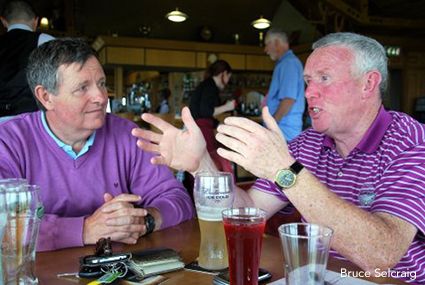
Though the joy of Glashedy, which opened in 1995, is simply its consistency in beautiful, challenging golf, you are likely to remember most holes 7 and 14, which use a monstrous dune to achieve heroic downhill shots that can vary from 8-irons to 3-woods depending on the wind. The 7th green is guarded on the right by a pond nearly twice its size and three deep bunkers. There's more than enough room to hold a variety of shots, but at the course's highest point, in typical stern winds, you'll be forgiven for not quite knowing the right club.
These two par-threes have become among the most photographed in Ireland, and yet they're far more than eye candy. Ruddy doesn't do postcard signature holes just to thrill the patrons, nor does he ruin your mood with impossible carries or stupidly penal swells that neutralize great shots. Probably the finest compliment you can offer him on these two exceptional holes is that you needed a full 60 seconds on the tee to just calculate the task before you. A Ruddy course says, yes, enjoy the view, but you truly need to think on every hole.
Among the features I enjoy the most about Irish links golf is the sense of seclusion. The fairways are natural valleys that run between the 60- to 90-foot-high dunes at many courses, and this canyon effect often completely blocks any view of commerce or the clubhouse or bellowing Yanks in the car park. You won't be able to count the number of times this peaceful solitude grabs you at Ballyliffin, but when you go, find the back of the 12th green, beneath the swale, a mile from any traffic, and you just might not want to emerge.
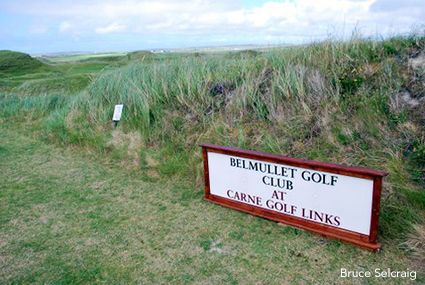
But it still gets better. The 13th, 14th and 15th join the 12th to form a quartet of holes unrivaled in Ireland. "I could continue playing a ball around those four holes forever," Ruddy has said, "and never get bored, as my results would vary so and the light and wind and the very mood of the place would change endlessly, but never fail to enchant."
It should also be noted that Ruddy did some extensive tweaking of the once-rabbit-infested Old Links as well. Faldo once called it "the most natural links" he had ever played, and I can't disagree. The dunes aren't as high and mighty as you'll hopefully find at Carne or Enniscrone, but this hardly matters. There's not a better combination of 36 holes in Ireland.
As word of The European Club's eccentric thrills spread across Ireland, so did the invitations for Ruddy to come to this or that club and see what alterations he might suggest.
And so the call came from Frank Casey, the new owner of an Old Tom Morris design at Rosapenna, some 57 miles west of Ballyliffin, north of Letterkenny. Ruddy did some tucking and trimming to the Morris links, and found nine entirely new holes that are a joy to play, but his real prize was hidden deep within the towering dunes beside the Morris.
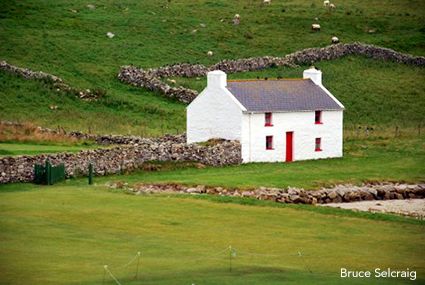
Ruddy calls them among the highest in the world – "miles of dunes clad by a sea of marram grass" -- a perfect canvas for a second 18 holes at Rosapenna to be known as Sandy Hills.
On the day I played Sandy Hills last July, without exception, every Irish golfer within earshot advised us that the course was difficult, which is usually their polite, we-love-tourism way of saying it can be too difficult for an average golfer on even a good day. As with the European Club, I don't find a single shot at Sandy Hills – ranked 11th best in Ireland last year by Golf World (UK) -- to be so comically penal that I hold a grudge throughout the round.
The first seven holes of Sandy Hills present the alluring Sheephaven Bay off to the right, but with Ruddy being Ruddy, he doesn't simply roll them out all parallel to the inlet of ocean, like footsteps in the snow. He bends them inward and out, facing the sea, facing inland, freeing up the tricky winds to create even more deception.
If you love photography, you already know the light at these latitudes is special, but for some reason Sandy Hills seems to attract more lingering views of rainbows than I recall elsewhere. Yet another reason to not ever quit on a rainy round in Ireland. When the rain stops, sometimes the best photos emerge.
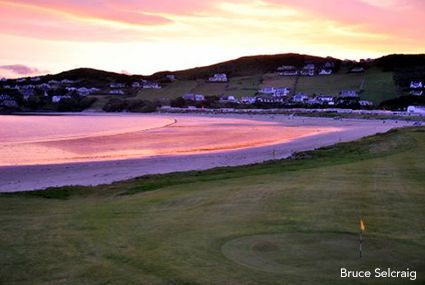
Ruddy delights in benign trickery.
"Confused?" he asks of the Sandy Hills hacker. "Good. The player can become quite confused, seeking a safe way through this great maze of fairways which is arranged so as to maximize the escape from reality, from daily strife, that golf at its best provides."
And, yet, Ruddy, who is a very good photographer, does not make you endlessly hike up mountainous dunes just to provide postcard scenery. "Those square-cornered tees on the tops of hills are a total abomination," he says, "and I am at pains to avoid them."
As for Sandy Hills' reputation for being some sort of Auld Links at Bethpage Black, he just smiles and reminds the critic that the course offers four sets of tees, with the tips at 7,177 yards. "Anyone choosing to go off a tee too far back for their game shouldn't accuse me of murder ... ," he cackles, "because it is they who are choosing to commit golfing suicide."

Rosapenna may emerge as a true golf destination someday. In addition to Sandy Hills, it has a beguiling and newly-renovated Old Tom Morris links right beside it that has hosted major Irish tournaments, a knockabout nine holes for evening fun, and, with the purchase more than a decade ago of 36 holes at neighboring St. Patrick's Golf Club, perhaps the dream of there being one day at least one more exceptional golf landscape in this little seaside holiday village.
So, now you've done County Donegal, with perhaps ventures to Murvagh, Rosses Point, Portsalon or the holy pilgrimages to Northern Ireland's Royals – County Down and Portrush – but to complete the best leg of our abbreviated Ruddy Tour, you must return to the East Coast, south of Dublin, and play The European Club, where Ruddy and his wife live, in lovely quarters above the clubhouse.
Don't be thrown by the parking lot. There are palm trees here and there, and no sign of the ocean, or even of a golf course. That is, of course, Ruddy by design. He welcomes you into the snug pro shop, or maybe you have an actual restaurant meal, not just snacks, in the dining room, but he has hidden the first tee euphoria until you actually walk onto the tee box for the first time. He has a sense of theatre.
Ruddy grew up the son of the local postmaster in a tiny village in West Ireland called Ballymote. He loved poetry and science, but longed for Spring afternoons when his teachers would allow him to sneak away with his father to play golf. Addicted to the game and certain of his future, Ruddy threw himself into golf writing.
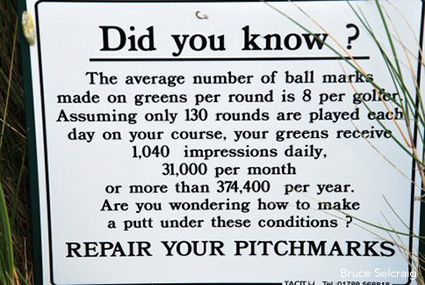
In the 1960s, he freelanced for the BBC and more than a dozen magazines and newspapers (from England to South Africa), and wrote five broadsheet pages of golf coverage every week for Dublin's Evening Herald. Covering one Open Championship, he slept on a park bench rather than pay extortionate hotel rates. In 1972, he launched a monthly magazine, Golfer's Companion, which he edited for 30 years out of his basement.
He also dreamt up events like a long-drive golf competition at a military airbase runway, where Irish European Tour player Liam Higgins established a world record with a drive (and roll) of 680 yards.
Ruddy loved his work, indeed barely considered it work at all, but there was always one larger goal, a lifetime dream.
Above all else, Ruddy wanted to design his own golf sanctuary, a modest place for friends, family and perhaps a few paying customers, a place where he could hit balls all day "without anyone saying boo," and where everything would be done on his terms. No outside investors, no hotel chain, and no stuffy club presidents breathing down his neck.
He designed several modest parkland golf courses in Ireland, but he wanted something more substantial. In 1980 he began to rent helicopters to fly over the Irish coast, hunting for an expanse of golf-friendly linksland that might be for sale. Named after the sandy soil that "links" the seashore to the inland farms, these stretches of rumpled peaks and valleys, strewn with knobby grass and furtive rabbits, have given golf some of its most celebrated playgrounds -- St. Andrews, Ballybunion, Royal Birkdale, Royal Portrush. There are about 170 true links courses in the world, and Ireland has more than 50 of them.
Hovering above the sea Ruddy quickly realized how much of the Irish coastline was dominated by marsh and cliffs. True linksland was in short supply.
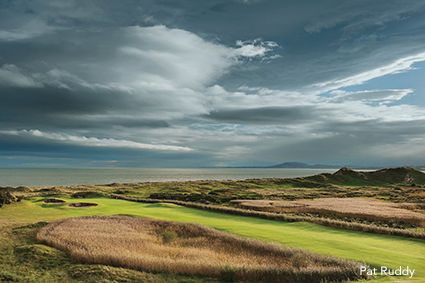
Finally, on his third flight, on a brisk, clear autumn morning, he spotted 300 promising acres with about a mile of Irish Sea frontage along Brittas Bay, between Wicklow and Arklow, some 35 miles south of Dublin. Rugged sandhills covered with waist-high marram grass and sprinkled with fluffy sheep rose as high as 80 feet and would-be fairways fell naturally between the gnarly dunes at various angles to the prevailing wind. Best of all, it was close to his new home at Glenageary, near Dublin's port, Dun Laoghaire.
Ruddy knew that appearing too eager to buy the land would just inflate its price, so he waited four years for the farmer to put the land up for auction. Meanwhile he raised cash by selling his car, re-mortgaging the house, and cashing in an insurance policy. He also applied for a bank loan.
But on the morning of the auction, as buyers crowded into a room at Wicklow's Abbey Hotel, the normally unflappable Ruddy was in a pickle. Fifteen minutes before the bidding opened, he still hadn't received an answer from the bank.
"Listen, I have to know now," Ruddy pleaded to his loan officer over the phone.
The banker demurred. His bosses were in no hurry to lend money on raw land.
"We'll call you tomorrow," came the reply.
Ruddy, who wasn't the gambling type, had to roll the dice. Two other golf-hungry buyers were also sniffing around the land. The bidding was brisk, but right at Ruddy's limit his rivals fell away and the 300 rugged acres along the bay became his, for something approaching a half-million pounds.
Next day the bank called. He got the loan.
At last the artist had his canvas.
Ruddy's rural roots ingrained a love for the land and a working knowledge of geology, wildlife and weather. Far from being intimidated by the prospect of carving out a golf course over years in often hellish wind and rain, the indomitable golfer saw it as his calling.
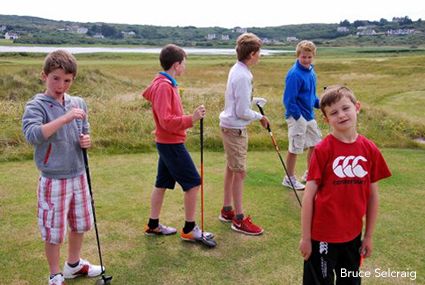
For six years, Pat and his eldest son, Gerry, barely a teenager at the time, scraped and shaped the rumpled tract of dunes, with little more than a 20-ton Volvo dump truck and a JCB excavator. Although Pat's wife, Bernardine, daughter Bernardine Jr., twins Sidon and Patrick, and baby daughter Zilla, chipped in, father and son estimate they built 90 percent of the course themselves, virtually saving the price of the land in labor costs.
Pat built and re-built greens and bunkers until he loved every last one of them. The elegant dunes, at times appearing "like a hall of mirrors" to their sculptor, revealed so many wonderful sites for greens that he built two additional holes (both par-threes) just for fun, making a total of 20 instead of the usual 18.
The obstacles were both comic and serious. One neighbor mysteriously "borrowed" a tractor for several days. Another constructed a noisy airfield. Acres of grass seed blew into the ocean. Ruddy broke his left foot three different times dismounting from machinery. Local environmentalists petitioned the European Union to stop the project, unsuccessfully.
Ruddy endlessly trimmed and buffed his personal playground like some prized poodle, and when he finally finished, the course sat easily on the land, like the missing piece of a giant jigsaw puzzle.
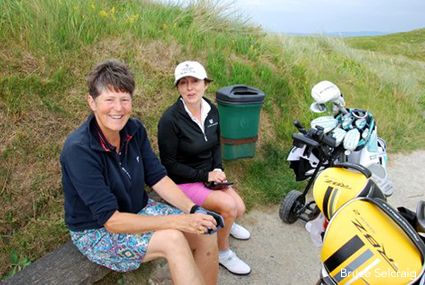
When it opened on December 26, 1992, Ruddy named his creation The European Club, which must have seemed like an inside joke to outsiders because its studiously unpretentious owner wasn't offering valet parking and nouvelle cuisine -- just exceptional golf.
His seemingly effortless routing of holes -- the true litmus test for great golf design -- reveals the ocean on no fewer than 16, and takes the golfer on a journey past a clear coastal marsh, a freshwater stream, onto the rocks of Mizen Head and almost onto the beach before returning to the modest clubhouse and dining room. There you won't find luxurious saunas or big-screen TVs, but stimulating conversation and "Marian's apple tart and cream," which Ruddy says was the winner of many he auditioned from members' wives. (A round of golf costs 180 euros.)
Even the scorecard bears the owner's wit. Beneath his admonition -- "Stay awake. Get Around Without Delays. You are An Athlete!" -- is a tiny box titled, "What my score should have been."
"Only the greatest lunatic would not think about selling the place and handing the profits to your five children," said Ruddy one afternoon as we strolled beside the Irish Sea. "But my curse is that I love golf. And I can't sleep in ten different houses."
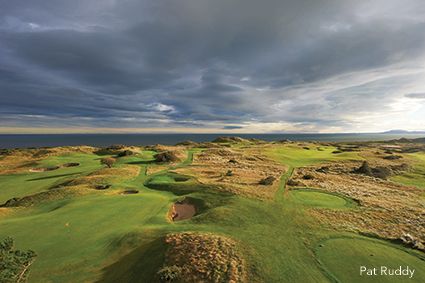
He scattered a bag of practice balls at his feet and began his rhythmic evening ritual, chipping them so crisply that they flew to the green with furious backspin, then came to a halt near the flag.
Gentle and curious, in his trademark cardigan-and-tie, Pat Ruddy, looks a lot more like a grandfatherly English professor than a golf baron. His family adores him. His children happily work full-time for him. He treats his workers well.
Each year on his birthday he closes the course and invites just friends and family to enjoy the peace and solitude. They may never see it quite like he does -- how could they? -- but they understand it is a monument to his perseverance and love.
And they understand what he's doing when he climbs to the highest part of the course, surveys it all and quietly says to himself, "Done."
-- Bruce Selcraig is a former staff writer with Sports Illustrated whose work has appeared in The New York Times Magazine, Harper's and The Atlantic, among others. Contact him at selcraig@swbell.net.
More By Bruce Selcraig:
-- Golf On Arran, Scotland's Isle Of Quirk
-- Santa Fe Golf Trail Of New Mexico: Gorgeous, Affordable And Still Overlooked
-- Louisiana Golf Plus Cajun Fiddles And Steaming Zydeco





